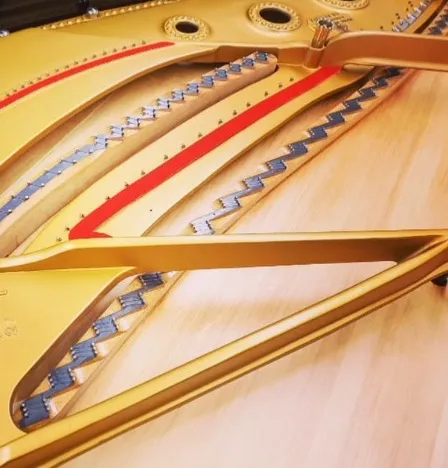Interview: Chris Maene on Beethoven and the development of the piano
Beethoven's life, from 1770 to 1827, coincides with the most interesting period in the history of keyboard building.
The speaker is none other than our very own Chris Maene, an expert on historical instruments, who will guide you into the world of Beethoven and his piano.
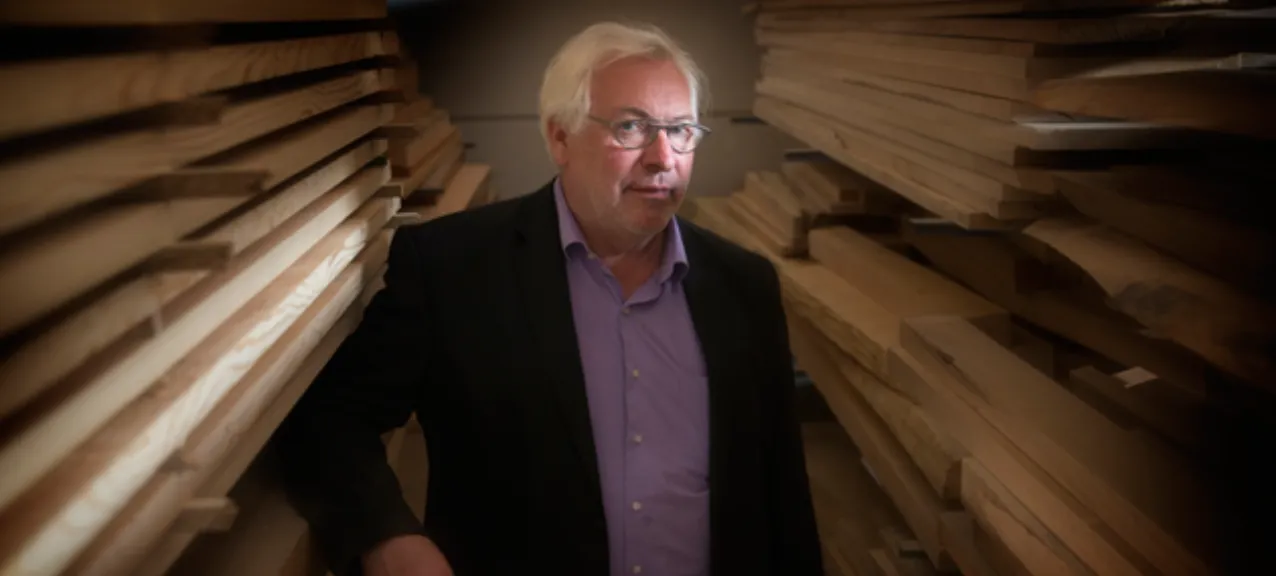
Context: How Beethoven shaped the evolution of the piano.
Each period, the lightly built and brightly sounding 18th century instruments with 5 octaves underwent a continuous metamorphosis into robust pianos with metal reinforcements and 6 1/2 octaves, thicker strings and larger hammer heads, resulting in a heavier touch response. Meanwhile, the pianoforte developed in three important centres: Vienna, London and Paris, each with their own building schools and typical characteristics. They competed with each other with constant innovations to conquer the European market. Successive changes in keyboard size, case construction, frame, soundboard, action, hammers and pedals resulted in an ever-increasing sound.
In Beethoven's time, an ever-growing market quickly emerged. Whereas the harpsichord was still the privilege of the aristocracy until the middle of the 18th century, the pianoforte became the living room instrument of the bourgeoisie.
Thus piano building evolved from craft to industry. At the end of the 18th century, Anton Walter was making 30 instruments a year. Twenty years later Conrad Graf was building more than 100 pianos a year, while Broadwood was already producing several hundred instruments. The number of piano builders also grew enormously. At the end of the 18th century, there were about 10 builders active in Vienna, 20 years later there were more than 50.
By the time of Beethoven's death in 1827 the piano had evolved so much that various builders already had all the elements of the modern grand piano: keyboard size of 7 octaves, Erard's double-action mechanism, Pape's felt hammerheads, Pape's cross-stringing, Erard's metal frame of 1822, Pleyel's of 1825. Between the 1770s and 1830s, the piano evolved more than in all the subsequent years.
Did Beethoven fuel the development of the piano?
We cannot assume that the plentiful developments in piano building coincided with the brilliant compositions of Beethoven, who is often unquestionably called the greatest piano composer of all time.
Due to the rapid changes in piano building, he was undoubtedly a groundbreaking piano composer who struggled in a love-hate relationship with the limited possibilities of the instruments available at the time.
With his compositions, Beethoven must have been an enormous stimulus for all the relevant piano builders of that period. Many builders tried to fall into Beethoven's grace in the hope that their instrument would be appreciated more and thus boost sales. Beethoven was always looking for new sound possibilities and was not loyal to the Viennese builders.
In 1803 he already owned an Erard that was so different in sound, touch, pedals and stop possibilities that this instrument was difficult to maintain by the Viennese builders with their completely different knowledge and values.
In 1817, Beethoven was offered a grand piano by Thomas Broadwood, who was trying to gain a commercial foothold in Vienna with it. This English piano had a totally different sound and playing characteristics to the Viennese piano, which opened up new possibilities for groundbreaking compositions.
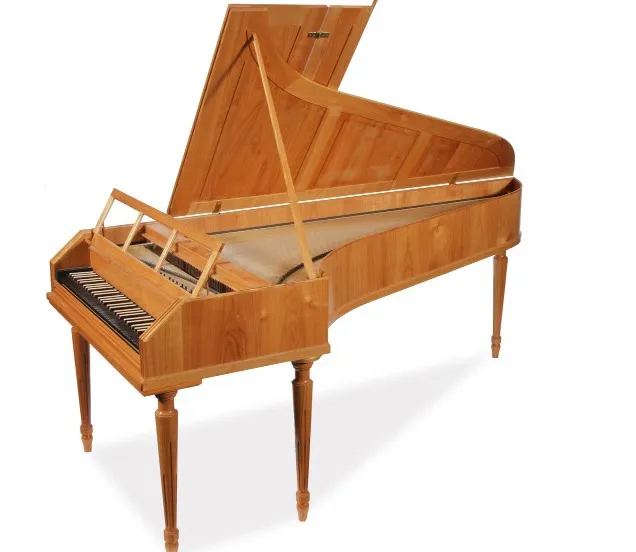
Beethovens pianos and their development
It has long been mistakenly believed that the modern piano is the end product of a long development in which the 20th century piano outperforms all its predecessors.
The successful restoration, the accurate reconstruction of historical pianos, and the many concerts and recordings on them have long since proved the contrary.
Piano music has developed over three centuries. This development was undeniably linked to the development of piano building. At different times pianos were made that perfectly met the requirements of the time.
More than with any other composer, the piano underwent a rapid development during Ludwig Van Beethoven's lifetime. If we want to perform Beethoven's piano music on the pianos that he knew, we need a multitude of instruments.
Johann Andreas STEIN
When the young Beethoven came into contact with the piano in Bonn, Stein's instruments were already well distributed there. Moreover, as a 17-year-old he visited Stein's piano workshop in Augsburg, where he got to know the characteristics of Stein's pianos very well.
The sound was clear and articulate, amiable and lyrical. The prelude mechanism enabled an extremely sensitive touch. The hammers had no catchers. This was not a defect but a choice. Just as with the clavichord and harpsichord, a hard touch does not improve the sound. With Stein's hammer mechanism this even resulted in a disturbing double stroke. The piano required a very subtle, controlled touch.
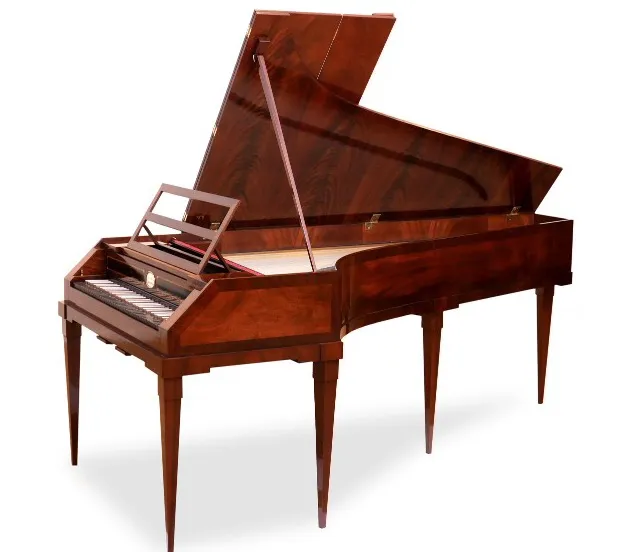
Anton WALTER
When Beethoven arrived in Vienna in 1792, he got to know Walter's instruments. He soon came to prefer them. The Walter prellcorder had catchers that ensured that the hammer was caught immediately after the stroke, thus preventing rebound. For these reasons, more powerful and brilliant playing is possible on the Walter. The soundboard and the wider comb also ensure a larger volume.
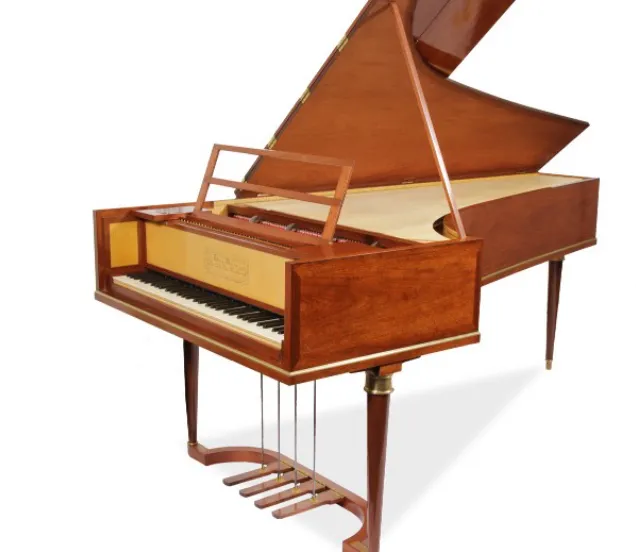
ERARD – Parijs 1803
While many Viennese piano makers were willing to supply an instrument free of charge to the young virtuoso, Beethoven himself wanted to buy an Erard in mahogany in 1802, with a 5.5-octave keyboard range and an una corda pedal.
It was strange that while Viennese piano building was in full expansion, Beethoven owned an innovative French grand piano by Erard in 1803.
The new mahogany instrument had a scale of 5.5 octaves FF-c'''', was fully 3-cornered and had a split comb for the basses.
The grand piano had 4 pedals:
- Lute (felt moderator)
- Damper
- Sourdine (buff)
- Keyboard shift due corde, una corda
This made the Erard grand piano sound fuller and more modern than the Viennese. This gave Beethoven the opportunity to give his works greater expansion.
The problem with this Erard grand piano was that the instrument depended on the defenders of the Viennese school for maintenance. They hardly understood the workings of the mechanism and thus tried to adapt the instrument to Viennese standards.
.webp)
FRITZ
Beethoven is known to maintain contact with several builders, often in order to have pianos available free of charge.
On the other hand, he was a source of inspiration for builders to create instruments that could possibly meet his expectations.
Whereas Anton Walter reached the absolute top in Vienna at the end of the 18th century with his 5-octave pianos, the honour went to several piano makers such as Fritz, Schantz, Streicher, Brodmann, Rosenberger and so on.
Although all these instruments differ from each other, both the well-restored originals and the faithful copies are perfectly suited to perform Beethoven's piano music.
The Fritz pianoforte of 1811 is a fine example of the perfection of Viennese pianos around 1810.
The keyboard range is 6 octaves FF-f''''. Basses and medium are 2-stringed. The discant is 3-stringed. The instrument has 4 pedals. Una corda, bassoon, moderator and damping.
The soundboard is thin and the bridges are split in the basses. The hammerheads are small and the touch is light and precise. The sound is broad and full and has a larger volume than the instruments from around 1800.
NANETTE STREICHER 1814
When Andreas Stein died in 1792, he was very famous. His daughter Nanette took over the business. In 1794 she married Andreas Streicher and settled in Vienna.
Until 1805 they made conservative instruments in the style of her father.
The Streichers are known to have maintained close contacts with Beethoven. They were among the first Viennese builders who sensed and recognised Beethoven's innovative ideas.
The powerful way of playing of Beethoven and his followers inspired them to design a new kind of 6-octave pianoforte. By interventions in the case construction, soundboard and mechanism, the tone became fuller, longer and more romantic than the sound of of the classical Viennese pianoforte.
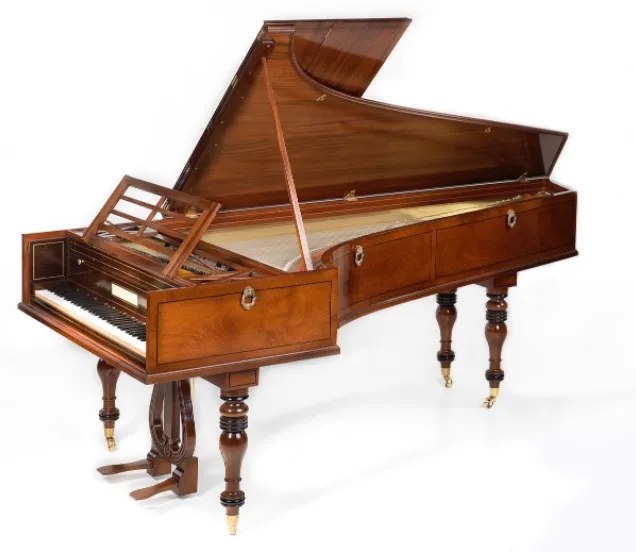
Broadwood 1817
In the first quarter of the 19th century, Vienna was the absolute centre of keyboard building in Europe. Besides composers and performers, many instrument makers settled there. London was the second centre. More pianos were built there than in Vienna, but a large part of them were table pianos.
The grand pianos in Vienna reached the highest level and were generally much more innovative than the Viennese ones. When Broadwood donated an English grand piano to Beethoven in 1817, he hoped it would help him set foot on the Viennese market.
This was complicated by chauvinism, but also by the large differences with the Viennese pianos. The case of the English piano was lighter, while the string tension was higher. This resulted in more carrying capacity and volume. The soundboard was deliberately thicker than in the Viennese, resulting in a long, appealing tone.
The relatively earthy sound of the English is the result of the point of attack being located more towards the middle of the string. The shape of the hammer heads, which have more leather than the Viennese, provide a milder attaque. The dampers in the basses are smaller and deliberately do not dampen well; they produce reverberation.
The due corde and una corda work very effectively. For all these reasons we can assume that this Broadwood is fully in tune with the grandeur of Beethoven's piano music.
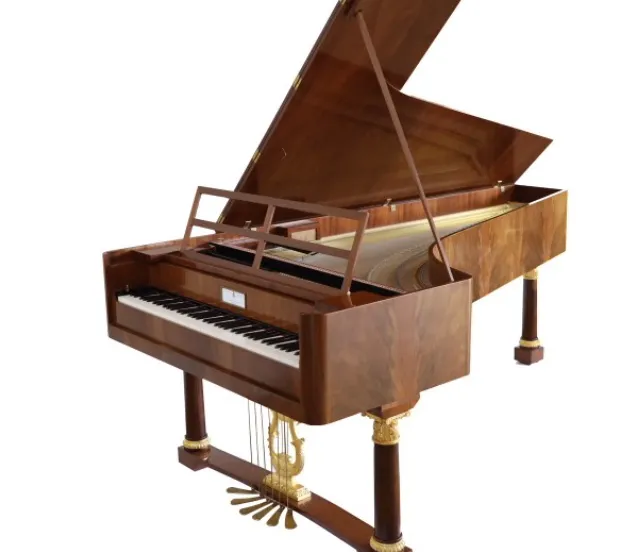
Conrad Graf
In 1825, Conrad Graf lent a pianoforte to Beethoven. Graf was one of the many new builders who settled in Vienna. He quickly became the most successful and famous Viennese piano builder.
His fame is attributed to high quality combined with a well thought-out production method. With 40 workers, he built up to 100 pianos per year. Graf still built his pianos in the Viennese tradition, but his instruments sounded bigger, longer and more romantic.
He copied Broadwood's soundboard to come closer to the English style.
Which instrument would Beethoven himself have preferred??
Although all previously discussed pianos were perfect at the time they were made, the evolution was so swift that they soon fell out of fashion.
The keyboard size went from 5 octaves to 5 ½ octaves then to 6 and then to 6 ½ octaves. The cabinet weight increased from 80 kg to 130 kg. The strings went from 2 thin strings to 3 thick strings per note. The hammer heads became larger, which made the touch feel heavier.
The sound evolved from classical to early romantic. The fact that Beethoven's compositions evolved quickly, his strict expectations and his progressing deafness mean that he always had higher demands and expectations. It makes me suspect that he was never satisfied with his pianos.
And which instrument do you prefer?
Out of all pianos available to Beethoven, the Broadwood and the Erard were the most innovative. They were instruments of a competing school of construction (the English and the French), which also profoundly changed the Viennese pianos.
Ultimately, it were the English and French pianos that lay at the foundation of the modern grand piano.
Would Beethoven have supported the introduction of the metallic frame?
Beethoven's death coincided with new developments in French and English piano building. Through the use of heavy metal bracing and metal plates, the tension on the strings could be increased, which significantly increased the volume.
The heavier hammer heads required a new type of mechanism that felt heavier than the Viennese ones. The Viennese builders always claimed that their Prell-mechanic played more precise and sensitive than the Stoss-mechanic and therefore they stuck to their wooden frame for several years.
If Beethoven were alive today, would he be playing the straight strung Chris Maene or a modern cross-string grand piano?
If Beethoven had lived in a time where cars, trains and aeroplanes existed, he would certainly have had the best hearing aid. His life would have been totally different, his compositions too. Let us be glad that he lived at the time of the early development of the piano and that he made a very important contribution to it with his compositions.
It was long mistakenly thought that the modern piano is the end product of a long development in which the 20th century piano is better than all its predecessors. Successful restoration, meticulous reconstruction of historic pianos, the many concerts and recordings on them have long since proved otherwise.
Over three centuries, piano music has evolved. This development undeniably went hand in hand with the development in piano construction. At different times, pianos were made that perfectly met the requirements of the time. More than any other composer, the piano underwent rapid development during Ludwig Van Beethoven's lifetime. If we want to perform Beethoven's piano music on the pianos he knew, we need a multitude of instruments.
And also this...
All modern grand pianos today have a cross-string system whereby the basses lie diagonally across the strings of the middle register. The slanting of the veins of the soundboard follows the bridge from treble to bass. All this ensures the homogeneous influence of the tone. A modern grand piano sounds beautiful and pure and all tones are balanced and in tune.
On Chris Maene's straight strung grand piano, the strings are logically placed next to each other. The veins of the soundboard lie in the same direction of the strings. As a result, the individual tones are amplified. This is very similar to the historic pianos that were characterised by register quality. This means that there is no unity of tone across the keyboard, but that the bass, the middle register and the treble have their own sound character. With the Chris Maene Concert Grand, this is an advantage over contemporary concert pianos because the tones of bass and medium are less woolly. This is a characteristic that Beethoven would certainly have appreciated!
Do you want to know more about the piano construction and the Chris Maene Staright Strung grand pianos? Then click the button!


